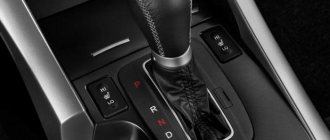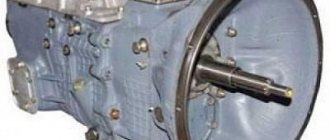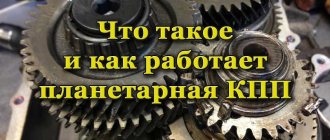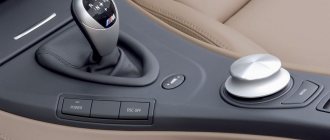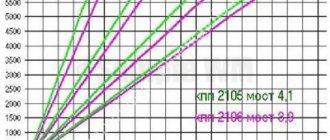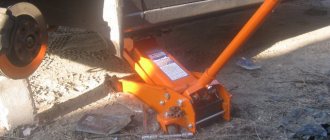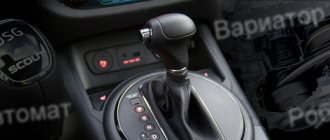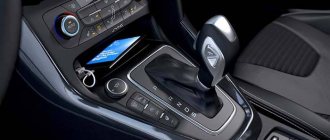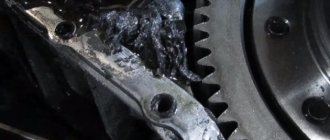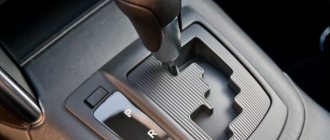Most people interested in the automotive industry are accustomed to the fact that a car can move either using a manual transmission, where all shifts are carried out directly by the driver from inside the car, or using its more comfortable analogue - an automatic transmission, which is independently responsible for changing gears. However, there is an offer on the automobile market for those who want to combine the dynamism of a manual transmission and the convenience of an automatic when driving a car - this solution is called a sequential gearbox.
Sequential gearbox
THE CONCEPT AND HISTORY OF THE DEVELOPMENT OF THE SEQUENTAL GEARBOX
It is not difficult to understand what a sequential gearbox is by understanding the meaning of the first word. The adjective “sequential” takes its roots from the English language and literally translated sounds like “sequence” or “sequence”. Accordingly, the presence of this type of gearbox in a car means that speeds can only be switched in strict sequence. Gear selection is carried out by moving the selector in only one direction, which is the difference from mechanics, where gears can be selected in any order. Sequential gearboxes began to be used by automakers back in the mid-90s. For example, the famous motorsport division installed the first generation of such boxes in its 3-series sports cars (M3 in the E36 body). Pre-sale testing has shown that the sequential transmission helps the driver tailor the car to his driving style better than using an automatic transmission, while maintaining the ability to independently influence gear changes with the same efficiency as a manual if sequential changes in speed are required.
Sales of copies equipped with a sequential gearbox showed that many drivers liked this alternative to more familiar analogues, however, from some buyers one could hear reviews about the relatively long gear shift interval. The situation was corrected by the release of the second generation of sequential gearbox and integration into the company’s new sports model with the M3 E46 index.
Dual clutch gearbox
BMW engineers did not stop there, and the third generation of sequential gearboxes has become a distinctive feature of their legendary M5 E60. With each new stage of development, the sequential gearbox was increasingly adjusted by designers to the needs of the consumer: the time spent on changing gears was significantly reduced, while the dynamics of the car with each shift increased noticeably.
Classification
The sequential gearbox is divided into a gearbox using a servo drive (with or without automatic) and a direct gearbox, mainly common on motorcycles. The operating principle of the latter is as follows: a transition is made to one top gear by moving the lever accordingly. The reverse algorithm is used to transfer to the lower one. The switch is located between the second and first gears, and the switch is switched on by partially retracting the lever.
Gears on cars are controlled using a lever that is used as a switch, as well as a mode selector. It is possible to use “petals” or buttons located on the steering wheel itself. The duplicated principle (lever + pedal) is used on tractors.
OPERATING PRINCIPLE OF A SEQUENTAL GEARBOX
The main task of a sequential gearbox, the principle of its operation when accelerating a car, is to reduce the interval between gear shifts. The use of a sequential gearbox as a transmission allows this to be achieved not only by maximizing the simplification of the shifting process, but also by eliminating the need for the driver to operate the clutch independently. The absence of a clutch as an additional pedal gives an advantage to both novice drivers, for whom getting used to all the intricacies of the driving process presents some difficulties, and pros, who operate the car to the limit of its capabilities and for whom every fraction of a second is a lot of time lost during acceleration. In fact, the sequential gearbox also has a clutch, but it is controlled using a separate electronic unit, which independently calculates, based on the current speed of the car and the driver’s force on the accelerator pedal, which gear is currently the most optimal.
gearbox, its operating principle
From this block a signal is sent to the transmission, to the location of the speed detection sensors. The next and final point of sending the signal after processing by the sensors is the progressive block - the unit responsible for correcting data on the operation of the internal combustion engine. In addition to data on the vehicle speed, the progressive unit also processes information about the operation of all elements of the comfort unit and, based on the totality of the data received, makes calculations to optimize movement.
How it works
We all know what an automatic or adaptive and manual transmission is. In the first case, the system does everything itself, based on the current loads and speed of the machine. That is, it adapts to the car. In the case of a manual transmission, you need to change gears yourself.
In the case of a sequential gearbox, it is important to note that it is distinguished by its ability to change speeds sequentially. Roughly speaking, if with a manual you can “jump” from 5 to 3 speed, then the sequential gear will not allow you to do this. There is a sequence of switchings that the automatic transmission cannot violate.
Initially, SKPPs were created for racing cars, Formula 1 cars and cars that take part in professional racing. But automakers liked the idea, which is why many are introducing such boxes into civilian cars. And it pleases.
The mistake of many is that they consider manual transmission to be an analogue of automatic transmission. In fact, the source of inspiration for creating the sequential game was mechanics. It was built on the basis of a manual transmission.
Let's consider the operating principle of this device and the key features of the SKPP. This way you will understand what it is and how the whole sequential system works.
- The automatic transmission does not have a clutch pedal. This is pleasantly pleasing for those who do not have much driving experience. Control is simplified, you do not need to constantly squeeze the clutch. Electronics are responsible for it, receiving signals from sensors when reading the gas pedal and engaging the gear. The box, having received a command from the control unit, transmits a signal through sensors about the speed at which the car is currently moving. The progressive block is the last stage where movement parameters are adjusted. He studies literally everything, from engine speed to whether the air conditioner is on or off.
- The design of the sequential machine uses spur-type gears. Their efficiency is higher compared to helical designs based on mechanics. The latter have impressive friction losses. Although straight teeth transmit less torque. To compensate for this, the gears are large.
- Hydraulic servo drive. The last distinguishing feature. Such a device switches between speeds. Now many are sure that the hydraulic servo drive is the property of robotic boxes. A common mistake, because they use electrical devices there.
The sequential machine works extremely simply. You can use the gearshift lever directly or the steering wheel paddle shifters. This is a technology borrowed from racing cars that has taken root very well among the people. Especially in the BMW and Toyota companies.
If you look at the box, you will see a lever on it that moves up and down. Plus there are additional modes, depending on the automaker.
Pressing up (where the + is) moves up one gear, and moving to the side with a “minus” allows you to lower the box by 1 gear.
This is what comfortable and convenient means. It is not surprising that many people want to install automatic transmission on their car. Some craftsmen manage to fit the box onto the VAZ 2108 and 2107. There are also factory models that are paired with a sequential one.
see also
Valet service mode: what is it, how easy it is to enable and disable
But I'll be honest. This is true for sports cars, from which you expect speed and minimal losses during acceleration. For a car with less than 150-200 horsepower under the hood, and which is used for family trips, there is no need for an automatic transmission.
DESIGN FEATURES OF SEQUENTIAL TRANSMISSION
The sequential gearbox differs from its competitors in the following unique features:
- The structure of a sequential gearbox is based on gears with straight teeth, and this is its main distinguishing feature from a manual gearbox, where helical gears are used as the basis. This difference lies in the advantage of the sequential gearbox, since spur gears, unlike their analogues, create almost no friction during the operation of the gearbox;
- also, the diameter of each gear is slightly increased in comparison with those used for manual transmissions, which allows more torque to be transmitted to the wheels;
Advantages of a sequential gearbox
- Another characteristic feature of the sequential gearbox is the use of a hydraulic servo drive. Uninformed drivers sometimes confuse hydraulic servos with automatic transmissions, thereby making a mistake, since the design, operating principle and resulting efficiency are significantly different.
Design, features, principle of operation of SKPP
You already know about the main feature of the sequential transmission - it is the impossibility of changing gears in any order (or rather, the lack of the possibility of free choice). But what is the point of such a box? The fact is that the driver does not always have the opportunity to engage the desired gear by braking (when moving from a higher to a lower gear) of the car. Especially in cases where the number of gears is large (from six and above), which is typical for agricultural machinery, tractors, and heavy vehicles.
Since there is no clutch pedal (but not the clutch itself), this theoretically simplifies driving - there is no need to synchronize the movements of the left and right legs when changing gears. The clutch is controlled by an on-board computer, which receives all the information necessary for this from sensors and sensors that monitor the degree to which the accelerator pedal is pressed and attempts to engage a certain gear. The ECU, analyzing this data, sends a corresponding signal to the actuator - the progressive automatic transmission unit, which adjusts the vehicle speed.
To have an idea of how a sequential gearbox works, you also need to know that, unlike its mechanical counterpart, spur gears are used here instead of bevel gears. This mechanism has a higher efficiency due to reduced friction losses, but at the same time the torque is reduced. This disadvantage is compensated for by installing gears of larger diameter. Note that the noise level when operating a transmission with spur gears is much higher.
ADVANTAGES OF SEQUENTIAL TRANSMISSION
Undoubtedly, the transmission used in sports cars from the world's most famous manufacturers cannot but have a number of strengths that set it apart from other proposals. The advantages of a sequential gearbox are:
- high gear shift speed is the main advantage of a gearbox on a sequential basis. Gear changes really happen instantly - in just 150 m/s. The reason for this high indicator was the previously listed design features of the transmission: spur gears with an increased diameter and a hydraulic-based servo drive;
- complete absence of loss of speed when switching - gears are not just switched at lightning speed, their replacement does not in any way affect the dynamics of the car;
- rapid achievement of the maximum number of revolutions - the sequential gearbox interacts better with the car engine, due to which gear shifts occur in the engine speed range that is optimal for rapid acceleration;
A sequential gearbox is not another name for a robotic gearbox.
- rapid achievement of the maximum number of revolutions - the sequential gearbox interacts better with the car engine, due to which gear shifts occur in the engine speed range that is optimal for rapid acceleration;
- no feedback to the driver’s hand in the form of oscillations and vibrations - again, thanks to the well-established gearbox mechanism on a sequential basis, this kind of discomfort will not bother the owner of a car with such a gearbox;
- reduced fuel consumption due to the design features of the gearbox.
IMPORTANT: in cars with a sequential gearbox, even shifting using the steering wheel paddles is much faster than in models with competing transmissions. This advantage can be decisive, for example, when competing for the best result in a straight line.
Tiptronic gearbox: pros and cons
The advantages of the box include:
The disadvantages include:
Any technically complex mechanism has both its advantages and disadvantages.
And as the practice of operating gearboxes shows, the driver uses tiptronic mode only 5-10% of the time. This trend begins to be seen already when buying a car. At this point, the sales manager explains to the buyer how to drive a tiptronic, but often hears the answer that the driver does not need it. Some European car models have automatic adaptive sequential gearboxes. Their main difference from the classic ones is that the adaptive automatic transmission adapts to the driver’s driving style and the rhythm of movement. If you drive a car in the city at low speeds, then such a transmission will quickly shift to an overdrive to achieve fuel efficiency. If you are driving along the highway, then the gear changes will be slightly delayed so that the car quickly picks up speed and quickly reaches the driving mode in a higher gear.
DISADVANTAGES OF SEQUENTIAL TRANSMISSION
Like other types of transmissions, the sequential gearbox also has negative aspects in operation:
- relatively quick wear - since cars with installed sequential gearboxes are usually driven very quickly, and this driving mode and aggressive driving style are constantly maintained, this leads to frequent breakdowns and subsequent calls to the service station. The electronic load distribution unit in the sequential gearbox is an advantage during acceleration, but can also cause a malfunction, since any untimely gear change completely disrupts the necessary algorithm and leads to destabilization of the entire system;
stereotypes of sequential checkpoints
- the cost of consumables and work to replace/install them - just as in the case of an electronic unit, the components of a sequential box are an advantage when it comes to speed characteristics, but the cost of repairing these mechanisms cannot be attributed to the advantages of this type of transmission . Repairing anything in it yourself is also a dubious prospect for the owner of a car with a gearbox on a sequential basis.
IMPORTANT: when repairing a gearbox on a sequential basis, only original spare parts must be used. Since the design of such a transmission is significantly different from manual and automatic transmissions, it will not be possible to replace most consumables with similar ones used in other transmissions.
Automatic transmission
Engineers were once given the task of making it easier to drive a car, and it was then that the automatic gearbox was invented. Its appearance significantly simplified the process of driving a car; the driver no longer needed to select a speed mode. The automatic transmission selects the gear itself, and the driver controls it only by pressing the brake and gas pedals. Driving a car with an automatic transmission is much easier and does not require special qualifications.
However, the process of modifying the gearbox did not stop, which is why a more advanced cam sequential gearbox appeared. For its operation, a clutch pedal is also not needed, as in an automatic one, but its operation is based on completely different principles.
MISCONCEPTS ABOUT THE SEQUENTIAL TRANSMISSION
A sequential gearbox is no longer an automatic transmission.
For ordinary people, the most common are two incorrect stereotypes about sequential checkpoints. We explain:
- A sequential gearbox is not another name for a robotic gearbox. Basically, the first uses a hydraulic servo drive, and the second uses an electric one;
- A sequential gearbox is certainly not an automatic transmission. An automatic transmission with the ability to switch to manual mode should not be confused with its sequential counterpart.
CONCLUSIONS ABOUT THE SEQUENTIAL TRANSMISSION A transmission on a sequential basis will be an excellent solution for lovers of dynamic driving and fast acceleration, who do not want to completely hand over control of the car to modern electronic assistants, but at the same time want to get not only maximum drive and adrenaline, but also combine this with comfortable operation, without the need for unnecessary movements and operations.
Disadvantages of sequential transmission
Wear
High load leads to rapid wear of this type of transmission. And the conversation now is not about the sports cars that you see on the Formula 1 racing track, but about ordinary cars. The fact is that the presence of an electronic control unit makes the gearbox very sensitive to loads, in other words, to untimely switching. Another proof of the statement “The more complex the mechanism, the higher the likelihood of it breaking.” Of course, if everything is done on time and unnecessary load is avoided, such a transmission will be durable.
Expensive service
We looked at the design of a sequential gearbox; it contains many electronic data counters and analyzer units. That is why the cost of maintaining such a transmission is very high.
